|
The public house has become
part of British culture, and one of the focal points
of the community. There were once over 120 pubs in
Darlaston, but sadly most have now gone, due to
changes in our lifestyle, and legislation. Just over
20 now remain.
The British public house can be
traced back to the Roman tavern or tabernae, and
later the Anglo-Saxon alehouse, which became so
popular that in 965 King Edgar decreed that each
village should have no more than one alehouse.
Although no records survive, it is likely that the
first public house in Darlaston would have an
alehouse. |
|
As long ago as 1393, King
Richard II compelled all landlords to erect a sign
outside their premises, which allowed people to
identify the alehouse by the picture on the sign,
and also make it obvious to the borough ale tasters,
who inspected, and tasted the ale.
Pub licensing began in 1552
when magistrates were given the power to license
alehouses, due to concerns about drunkenness and
public disorder.
In the 18th century, gin
replaced ale as the most popular drink, after the
Dutch brought it here in the late 1680s. It was
cheaper, more alcoholic, and readily available.
Drunkenness became commonplace, and on several
occasions the government introduced legislation in
an attempt to reduce the problem. It was in this
atmosphere that the modem public house was born.
The 1830 Beer House Act
Beer was considered to be a
harmless, nutritious alternative to gin, the
consumption of which should be actively encouraged.
This idea led to the Passing of the 1830 Beer House
Act that introduced new and radical changes in the
law. It allowed any householder and tax payer to
obtain a license to sell beer on their premises, in
exchange for a 2 guinea licence fee. Licensees were
not allowed to sell spirits or fortified wines.
Anyone doing so would be closed down, and heavily
fined.
|
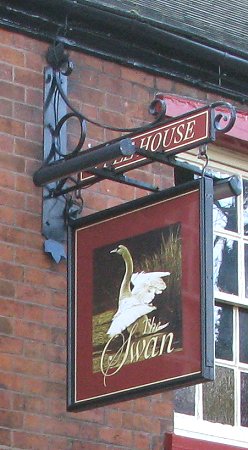 |
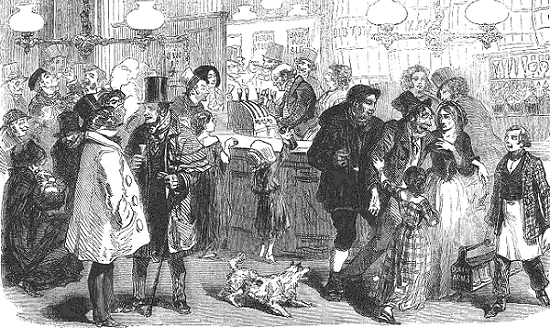 |
A typical gin palace.
An illustration from 'The Working
Man's Friend and Family Instructor' published in 1851. |
|
The new legislation led to a
rapid rise in the number of public houses, and the
introduction of a new class of licensed premises,
the beer house. Beer houses were family homes, in
which beer was usually sold in the front room, and
dispensed from a jug, or directly from the
barrel. Often the room was simply furnished with
bare floorboards, wooden benches, and trestle
tables. By 1851 there were 20 pubs and 73 beer
houses in Darlaston, and 6 maltsters.
Some of the early beer houses
carried names, just like pubs. They included The
Woodman, in Blakemore Lane, The Unicorn at
Catherine's Cross, The Vauxhall in The Green, and
the Rose and Punchbowl in Cramp Hill. Some of the
more successful beer houses eventually became pubs,
such as the Queen's Head in King Street, the Noah's
Ark in Pinfold Street, The Fountain in Walsall Road,
and the Fortune of War in Smith Street.
Beer houses flourished until
the introduction of the Wine and Beer House Act of
1869, which prevented the opening of new beer
houses, and tightened local magistrates' control of
the industry. By the early years of the 20th century
they had all gone.
|
|
Early pubs
Many of the early pubs were
coaching inns, so called because horse-drawn coaches
or omnibuses would stop there for a change of
horses, and to pick-up, and drop-off passengers, and
sometimes mail.
Travellers would be provided with food,
refreshments, and often accommodation. Stables were
provided for the horses. |
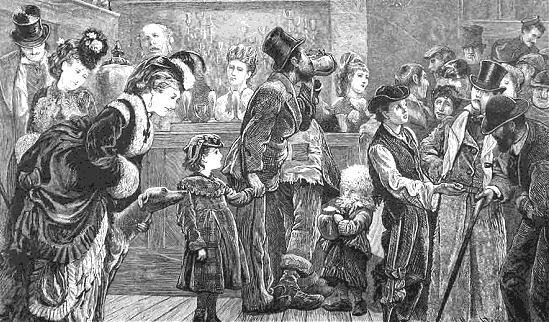
An illustration of an old public bar
from an early public house. |
|
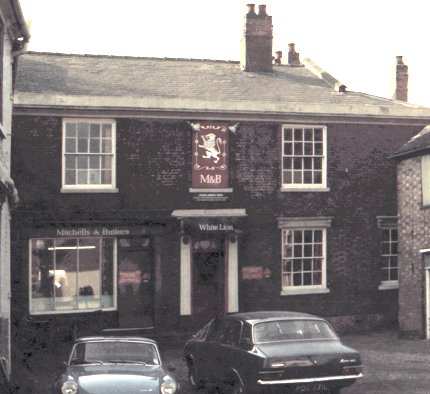
The White Lion in King Street. |
Coaching inns
in Darlaston included the White Lion in King Street,
where coaches called on route to Birmingham, The
Bell in Church Street, from where Thomas and Obadiah
Howl's omnibuses travelled to Birmingham and
Wolverhampton, and the Waggon and Horses in King
Street, where George Bayley's omnibus began its
journey to Birmingham and Wolverhampton.
Horse-drawn coaches and
omnibuses quickly disappeared after the coming of
the railways, and the appearance of trams.
Darlaston's first railway station at James Bridge
opened in 1837, and its second railway station,
Darlaston Town, opened in 1863. The town's first steam
trams appeared in 1883, followed by electrically
powered trams in 1893, by which time the fast and
reliable train and tram services had replaced the
old horse-drawn omnibus.
|
|
Soon after the opening of James
Bridge railway station, a new pub, the James Bridge
Hotel was built. It offered similar facilities to a
coaching inn, but catered for the railway.
The pub became known as the Railway
Tavern, and survived until November 2010.
It was located in
a hollow which occasionally flooded when the nearby River
Tame burst its banks.
During one flood in August 1966, the
pub was 3 feet deep in water.
|
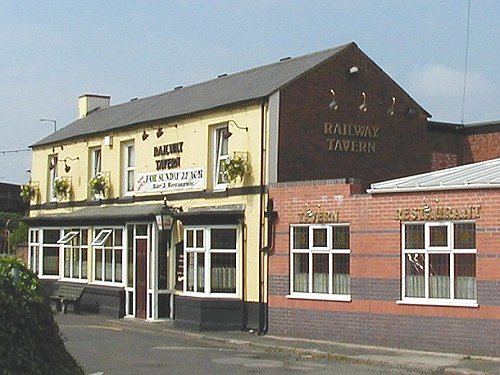
The Railway Tavern at James Bridge. |
|
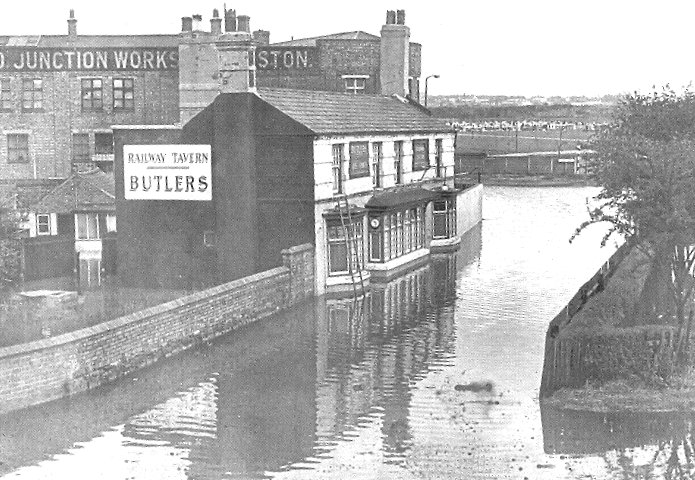
The flood in
October 1967. |
| The pub had a lucky escape at the end of July 1942 on
the same evening as the bombing of All Saints' Church. A 500 lb. German bomb fell on part of the cinder wall in
front of the pub, and luckily failed to explode. Had
it done so it would have destroyed the Railway
Tavern, and the adjoining cottages. Most people will
remember it as an isolated building, but for many years it
was surrounded on two sides by houses. There were two houses
next to it in Cemetery Road, the first being a private
residence, the other a small sweet shop. The other houses
were around the corner in Kendricks Road, opposite 'Bogie
Wilkes' factory. Many landlords brewed their own
beer, and sometimes supplied it to other pubs and
beer houses. There were several breweries in the
town, including one behind the White Lion, which
from 1870 was used for meetings of the Darlaston
Local Board, and also as a drill hall for the
Darlaston Volunteers. Another brewery, known as
Darlaston Brewery, stood next to the Bell in Church
Street, on the site that is now occupied by Haden's
Solicitors. It opened in 1818 to supply beer to the
pub, which at the time was called the Blue Bell. The
brewery was run by the licensee, William Foster, and
afterwards by successive licensees. Although
initially it only supplied beer to the Bell, it
later became a business in its own right, selling
beer to other establishments. In the early 1840s the
licensees were Thomas and Obadiah Howl who operated a coach
service from Birmingham to Wolverhampton.
|
|
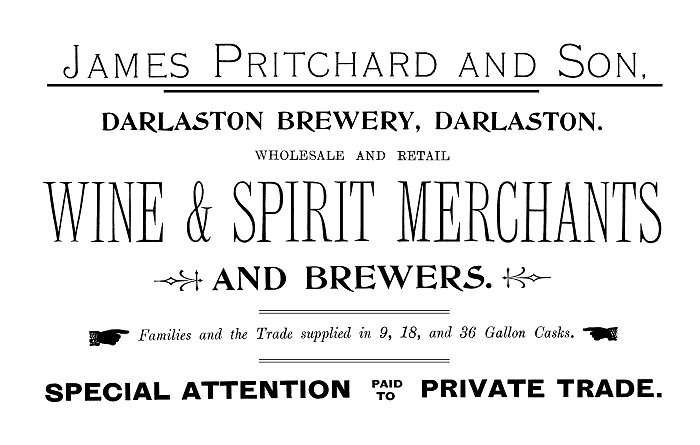
An advert from 1897. |
| From the late 1840s until 1871
the licensee was James Pritchard. In 1849, James and
his son, James junior, founded Pritchard's Ales,
Wines and Spirits Company, which was based at the Brewery. The
business survived until 1946 when it became part of
William Butler and Company.
Another brewery, Blockall Brewery, run by John Green, stood behind a
beer house in Blockall, on the site later occupied
by the Olympia Cinema. It operated for
roughly 20 years from around 1880 until the early
1900s.
Other pubs had a small brewery, or brewhouse
at the back, including the Freemason's Arms in The Green,
The Old Crown Inn, in Cramp Hill, and the Three Horse Shoes
on the Bull Stake |
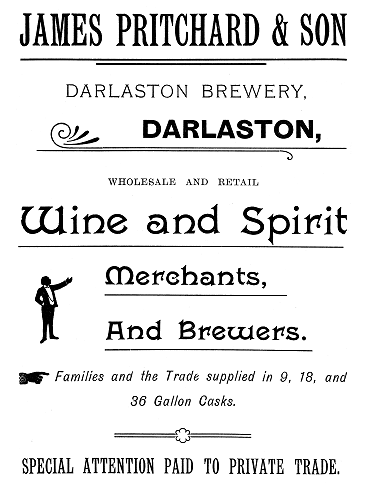
An advert from 1900. |
|
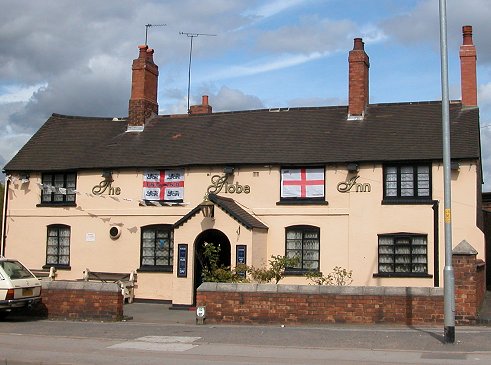
The Globe Inn at James Bridge,
believed to date from the early 18th century. |
Some of the more successful licensees became extremely
affluent, and invested their money in land and property.
One of them, John Aldridge, licensee of the Old Bush in
Bush Street, purchased an area of land between The Green and
Bush Street, and sold building plots on either side of a
road that he created in the middle. He called the road
Aldridge Street.
He also sold plots in part of Green Lane, which he
renamed Bush Street, after the pub. |
| Another landlord, Charles Foster of the Bell Inn,
purchased a piece of land known as "Wilkes' and Shale's
Crofts" and divided it up into building plots. He had roads
built and called the development "Charles Foster's Building
estate". One of the roads,
Bell Street was named after the pub, and another,
Foster Street was named after Charles Foster
himself. Plots were sold by private contract, and at
an auction held at the Bell on 2nd May, 1836. In the 1830s, the Horse and
Jockey in Walsall Road was run by Joseph Corns. He
acquired an area of land off Birmingham Street and
had Corns Street built there. He also sold building
plots on either side of the street. The main
entrance to the headquarters and depot of the South
Staffordshire & Birmingham Area Steam Tramway
Company, which operated steam trams from 1883 was in
Corns Street. It later became the main depot of the
South Staffordshire Tramways Company Limited which
began to operate electrically powered trams in 1893.
The Evolution of the
Traditional English Pub
The traditional English pub
evolved into several separate rooms, each with its
own purpose. The bar, with a counter, was copied
from gin houses, where the idea was to serve
customers quickly, and keep an eye on them. The
saloon bar, or lounge, appeared in the latter part
of the 18th century, as a comfortable, carpeted, and
well furnished room with an admission fee, or higher
priced drinks. It catered for more affluent people.
Often entertainment would be provided, and drinks
were served at the table.
The tap room, or public bar,
was developed for the working classes. It had simple
wooden bench seats, cheap drink, and bare
floorboards, or tiles, that were often covered in
sawdust to absorb spillages, and spit.
Another room, the snug,
sometimes called the smoke room, was a small,
private room where people could drink without being
observed. The windows were made of frosted glass,
and the room had a separate entrance to the bar, so
that people could enter and leave without being seen. There
was usually access to a separate section of the bar,
where a higher price would be paid for drinks. The
snug was often used by ladies, at a time when the
pub was perceived to be for men only, and also by
courting couples, who liked their privacy.
There was often an off licence,
where beer, wine, or spirits could be purchased for
home consumption. It was a small room with a
counter, or often just an open window facing the
back of the bar, through which people were served.
Customers, including children, sent on an errand by
their parents, could take bottles to be filled with
beer. A paper seal would often be stuck over the
stopper to ensure that the children didn't sample
the contents.
Entertainment, Games and Food
Public houses have always been
associated with music, from a simple sing song, to
musicians who performed in the early saloon bars. A
piano became an essential part of the local pub,
encouraging talented customers and musicians to
entertain the locals with a variety of popular and
traditional tunes. This is very different to the
juke boxes, karaoke nights, and disk jockeys that we
have today.
|
| Games have been played in pubs for a long time,
originally consisting of billiards, snooker, card games,
darts, dominoes, and skittles. Many pubs had their own
football team, often playing in the local league on a
Sunday.
In the late 1890s Darlaston Football Club had its
headquarters at the George in Church Street. Others had a
bowls team, and a bowling green, such as the Duke of York in
Moxley Road, the New Inn in King Street, and the Railway
Tavern in Cemetery Road. |
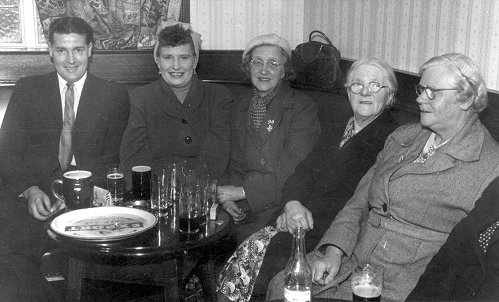
The comfortable seating in the snug at
the New Junction in Forge Road, in the late 1950s. |
| There were boxing gymnasiums at the Royal Exchange in
Catherine's Cross, and the Dog and Partridge in King Street. A once popular Black Country
pastime was pigeon racing. Followers of the sport
would join one of the many flying clubs, each based
at a local pub. Such clubs could be found at
Herberts Park Tavern in Forge Road, the Rose and
Crown in High Street, Moxley, and the Cottage of
Content in Bull Street, where the licensee, John
Nicholls was secretary of the Cottage of Content
Flyers Club. His pigeon loft was behind the pub.
Another popular activity was
cycling, which led to the formation of countless
cycling clubs throughout the country. They were to
be found in most towns, including Darlaston. The
headquarters of the Mason Cycling Club was the Rose
and Crown in Cock Street, where the landlord John
Wood was club secretary.
The Bell in Church Street had
the dubious distinction of being the first public
house in Darlaston to have a television set in the
bar.
Food has been served in pubs
for a long time. Originally it consisted of bar
snacks such as crisps, peanuts, pork scratchings, or
pickled eggs. The only meals on offer might be simple cold snacks
such as the ploughman's lunch. This gradually
evolved into the high quality pub meals that we now
expect, greatly assisted by the development of the
microwave oven.
Dual Occupations
Before the First World War,
families were often much larger than they are today.
Some pubs were not profitable enough to support the
licensee and his or her family. Many licensees ran a
second business which was sometimes based in part of
the pub. One such licensee, Samuel Canlett, landlord
of the Swan in Victoria Road, was also a pork
butcher. Pigs were slaughtered outside, at the back,
and joints of meat were hung upstairs to be cured. Some of the original
hooks on which the meat was hung, still survive. The pork and bacon was sold in
the little room to the right of the
bar. Other butchers included George Wilkes, and
Benjamin Cole of the Green Dragon in Church Street. |

Some of the surviving hooks in the ceiling.
|
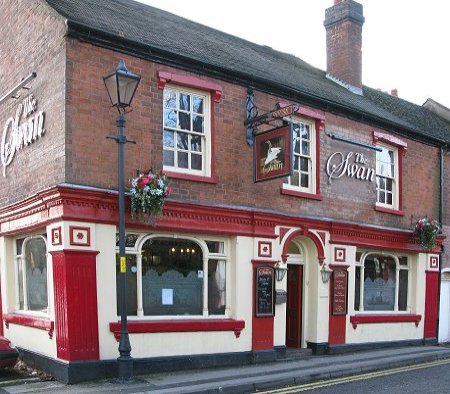
The Swan in Victoria Road. |
A fairly common second
occupation was gun lock making. One of the last
surviving gun lock workshops in the town was run by
John Stokes, licensee of the Old Castle Hotel on the
Bull Stake. The workshop, which was behind the pub,
survived until the early 1970s.
Other gunlock makers
and licensees included Edward Corbett of the
Bradford Arms, William Wilkes, Mrs Wilkes, and James
Wilkes of the Vine in Bell Street, John Stanway of
the White Lion, and George Golcher of the New Inn in
King Street. |
|
Thomas Newton, who ran the
Black Horse in Pinfold Street, had a nut and bolt
factory behind the pub, employing several nut and
bolt forgers. James Rose of the Waggon and
Horses in King Street was one of the partners in
J &
R Rose Limited, nut and bolt manufacturers in London
Works, Willenhall Street. Other second occupations
included file making, padlock making, shop keeping,
farming, and auctioneering.
More Darlaston Pubs
Many pubs were kept for long
periods by the same family, and became known by that
families' name, rather than the true name of the
pub. The New Junction in Forge Road was known as
"Aston's" and the Spread Eagle in Cramp Hill became
"Martin Perry Foster's". Others had nicknames
such as the Dog and Partridge in King Street, which
was known as "The Coffin Handles" because of its
brass door fittings. The Bradford Arms was
universally known as "The Frying Pan", the Royal
Exchange as "The Widders", the Railway Tavern as
"The Ole", the Dog and Pheasant as "The Wrexham",
the Barrel as "Paddy Mac's", and the Dartmouth Arms
as the "Blazing Stump".
One of the most well known pubs in the
town was the Bradford Arms in Bilston Street, which
consisted of three very old separate buildings from
different periods.
|
| The regulars called it "The
Frying Pan", and formed a frying pan club. The club
met on Sunday nights, when each member had to bring
along their badge, shaped like a frying pan.
If
anyone forgot to do so they had to pay a fine.
A
password had to be known, and any member caught
lighting their own cigarette, or lifting their glass
of beer with their right hand, also had to pay a
fine.
The money raised from the fines went to local
charities. A different chairman was elected each
week, the symbol of his office being a top hat and
chain, with a pendant in the shape of a frying pan. |
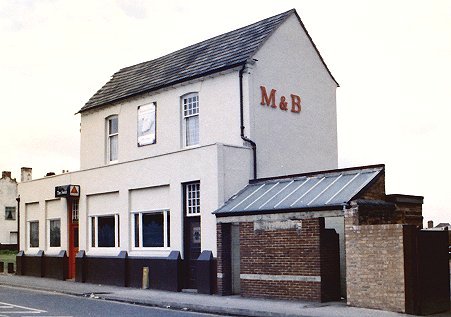
The other Swan, that stood at the
western end of Moxley Road. |
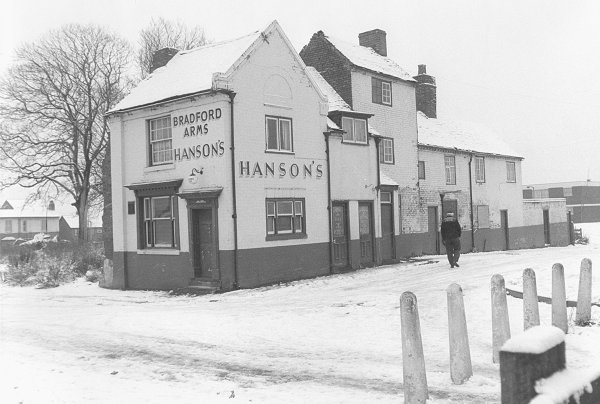 |
The Bradford Arms, known locally
as 'The Frying Pan'.
As it was in 1973. |
|
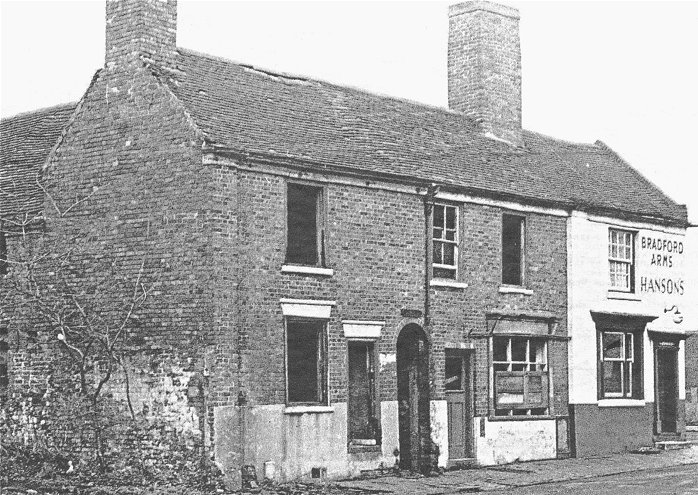
The adjoining shop and house that
were soon to be demolished. |
|
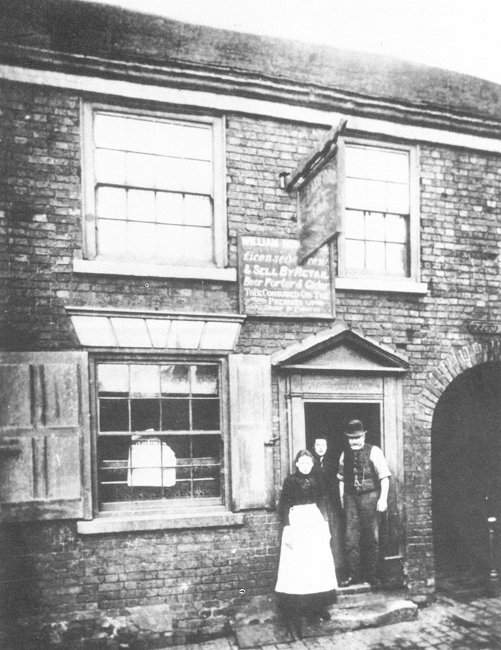
The Bradford Arms. The man on the
doorstep is believed to be William Howells. |
The Bradford Arms originally had a beerhouse license
and was called the Hatherton Arms. The licensee from
1901 until 1923 was William Howells, who is possibly in
the photograph on the left.
When the pub was built, Eldon Street didn't extend as
far as Bilston Street and the arch on the right of the
photo, led to a yard at the back.
When Eldon Street was extended, the right-hand corner
of the building, including the arch and two other
buildings to the right, were demolished to make way for
the extension.
The Bradford Arms closed in 1982 and was soon
demolished. |
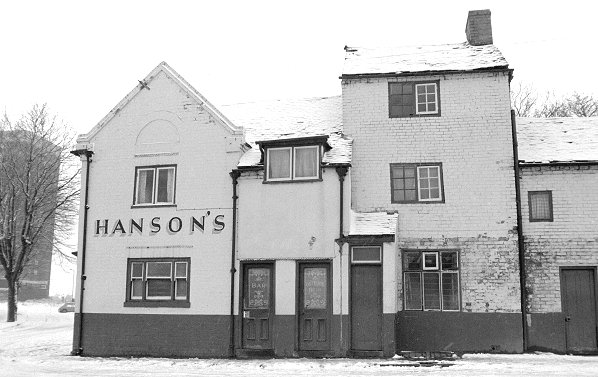 |
Another view of the Bradford Arms. |
|
The Black Horse pub was the
oldest public house in the centre of Darlaston, dating from the
late 18th century, and the headquarters of the
town's horse racing fraternity. It had a traditional
spit and sawdust bar, complete with spittoons.
A well-liked and respected
licensee in the town was Martin Perry Foster who
became landlord of the Spread Eagle in Cramp Hill in
1881. He was born in November 1849, and married Mary Adams in
1870. They had 8 children to support, and so he had
a file-making workshop behind the pub. Martin died
on 23rd February, 1931 at the age of 81, after
running the pub for over 50 years. He is buried in
James Bridge Cemetery, and was succeeded
as licensee by his daughter Ethel. The pub survived
until the mid 1950s.
|
|
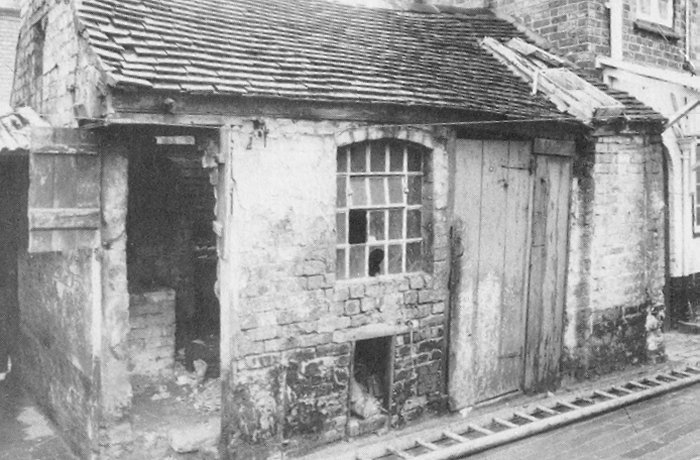
Martin Perry Foster's file-making
workshop. |
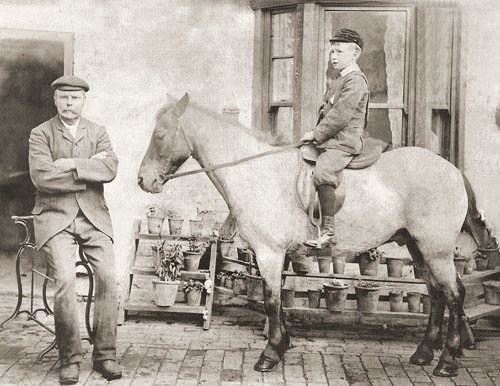 |
This fine
photograph taken at the back of the Spread
Eagle at 50 Cramp Hill was kindly sent by
Ian Beach.
On the left is Martin Perry Foster. Seated on the pony
is his nephew William George Yates. |
| The Foster family's grave at James
Bridge Cemetery.
As seen in February 2019. |
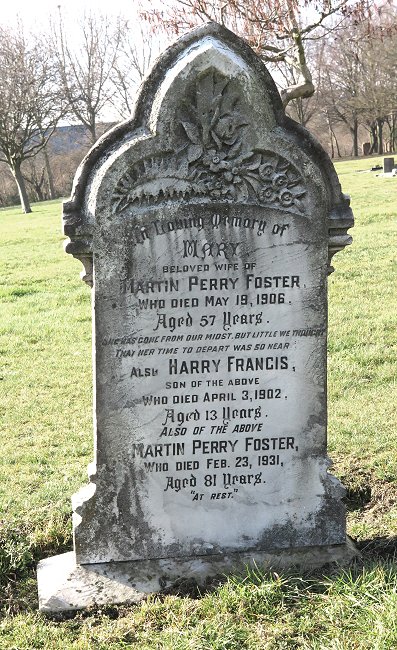 |
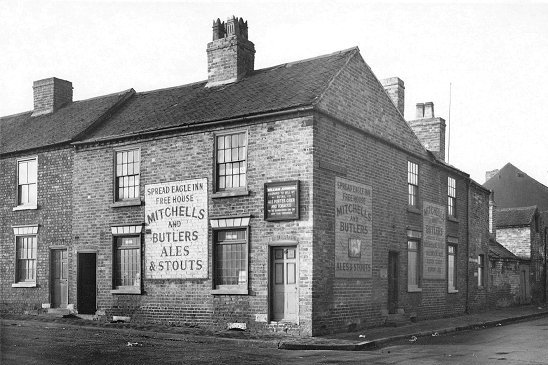 |
This lovely photograph of the
Spread Eagle was also sent by Ian Beach.
At the time the licensee was William Johnson. |
|
A basic, old fashioned pub, in
the same form as a beer house, survived in Foundry
Street until the late 1950s. This was the Lamp,
which for many years was run by Harry Humpage. It
had a small bar in the front room, with beer pulls
in the kitchen. There was gas lighting, and food in
the form of roast potatoes and sandwiches. Blocks of
salt were stored in a small cupboard, but before you
could use one, you had to scrape off the dirt. At
the end of the day Harry would call time, and
personally finish off any left-over drinks. The Lamp
was replaced by the Aladdin's Lamp in Wiley Avenue
South.
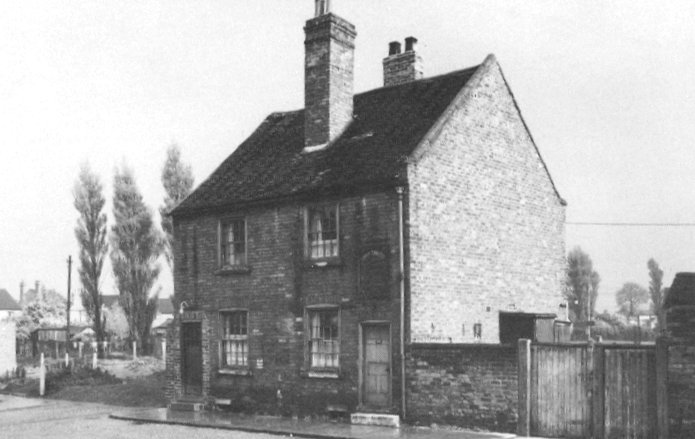
The Lamp Tavern in Foundry Street.
The Public House Today
|
|
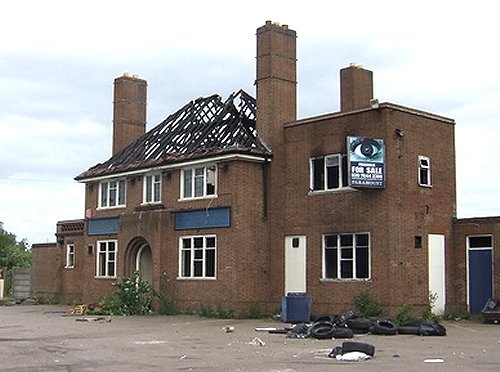
The sad looking, derelict Boat in
Bentley Road South. |
Sadly many pubs have disappeared within the last few
years, and still continue to do so. The pub was used mainly
by working class communities, which have now largely
disappeared.
Worries are expressed about binge drinking amongst the
young, and alcohol related crime. Many youngsters prefer
drinking in clubs which often open throughout the night.
People now drink at home, taking advantage of the cheap
beer, wines and spirits that can be found in the local
supermarket. |
| The smoking ban, and tougher drink-drive regulations
have also had an impact, as has the downturn in the economy. The pub always has been, and
still continues to be part of community life. Most
pubs are now also restaurants, which cater for the
young and elderly alike. Large sums of money are
spent on converting traditional pubs into eating
establishments, which have become very popular.
Recent losses include The Boat
in Bentley Road South, which ironically in 2005 was declared pub of the year by
the Walsall branch of CAMRA. Less than 12 months
later it closed. Within the last few years the
derelict Moxley Arms disappeared, as did the Railway
Tavern. |
| Although pubs are still
vanishing at an alarming rate, most are still
evolving to cater for people's changing
requirements, and tastes. Many are extremely
successful, and should continue to be so in the
future. The Three Horse Shoes in Pinfold Street is
now residential accommodation, after many years of
dereliction.
Some of the buildings such as the White Lion
in King Street are listed, so even when their use
changes, they continue to survive.
Luckily a number
of the more traditional pubs have survived, and are
very profitable. So hopefully they will still be a
part of community life for many years to come. |
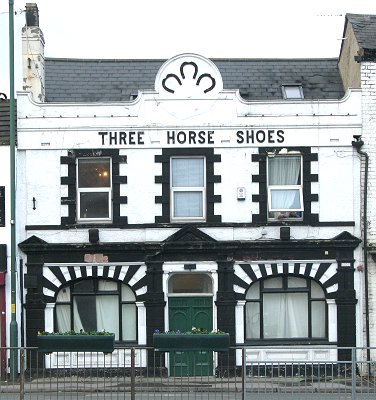 |
|
 |
|
Return to the
previous page |
|